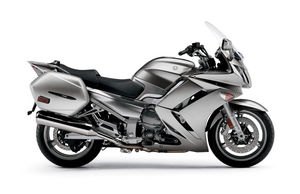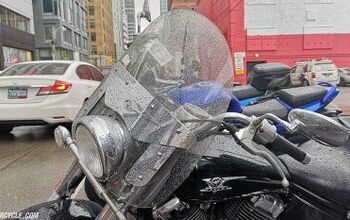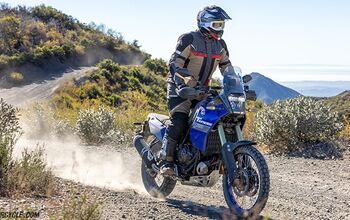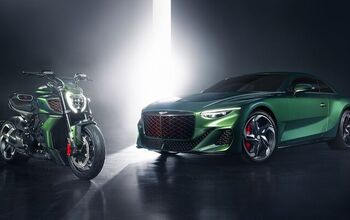2006 Yamaha FJR1300 Model Intro - Motorcycle.com
Loud techno music pulsates in every nook and cranny of the posh W Hotel in downtown San Diego, an ultra-hip, ultra-modern hotel catering to the whims of the post-industrial, post-dot-com, post-post-modern high-fashion poster-children of the early 21st century. So many beautiful, stylish people come and go from the over-decorated lobby you think you're watching a sequel to The Matrix being filmed.
It's a perfect place to launch Yamaha's heavily-revised 2006 FJR1300, a model that gobbles a large portion of the United States' Sport Touring market, as Yamaha thinks the kind of buyer interested in an ultra-sophisticated, $13,000 sport-tourer would also stay at a stylish place like the W. Last year's model was a good motorcycle but one that didn't stand out in a market niche that even though small in this country, is starting to offer a lot of choices to buyers. Yamaha wanted to make the model more appealing and competitive; how would they do it?
Yamaha gathered the usual motley assortment of journalists, website editors, porn stars and free-lunch poachers in lovely, fog-bound San Diego, California to show a revised FJR1300 Sport-Tourer. Aside from multiple tweaks to the chassis and fairing, Yamaha is making available as an option an electric-shifting mechanism, eliminating the clutch lever completely in an attempt to broaden the appeal of this already appealing motorcycle. Are all the changes enough to make a difference?
Yamaha, of course, says yes, and to prove it they subjected us to a 90-minute tech briefing.
First, Yamaha's Derek Brooks told us a bit about who is buying Sport-tourers in general, and FJRs in particular. Since 2002, the Sport-Touring market has grown 35 percent, according to the Motorcycle Industry Council, and as of 2005, Yamaha's FJR accounts for 28 percent of the bikes sold. Not too bad for a bike that is built to order and sold sight unseen.
The FJR owner is about 10 years younger than his counterpart purchasing other brands, and he also rides his motorcycle a few hundred miles more per year than the average Sport-Touring rider. She is a more experienced rider than average, but she also appreciates the performance that the big four-cylinder engine and stout aluminum chassis provide. For 2006, Yamaha's product planners hoped to broaden functionality and appeal.
The motor and chassis have stayed almost the same, but we'll give you the basics. The motor is the same four-cylinder, liquid-cooled, four-valve per cylinder DOHC mill displacing 1,298 cc as the older model, right down to the 42 mm throttle bodies and Nippon electronics. Last year's pumped out 127.55 hp and 91.2 foot-pounds of torque at the back wheel on the MO Dynojet Dyno, and the 2006 should be about the same, perhaps altered slightly by taller gearing and the addition of an extra catalytic converter in the stainless steel four-into-two-into-one-into-two ("seven-eight-nine, you can call me up and have a date, any old ty-yime") exhaust system.
The basic frame is the same, but what is bolted to it has been altered. The swingarm gets an extra 35 mm of length to improve suspension action, traction and stability, and there's a redesigned bolt-on subframe that provides a nice, sturdy handhold to help the rider prop the heavier-than-it-looks FJR onto its sidestand. It also mounts the locking sidecases (which include soft liners) inboard two inches to aid those of us blessed enough to lane-split legally. The new swingarm extends the wheelbase to 60.8 inches (from 59.6), but rake and trail figures remain the same; 26 degrees and 109 mm. The numbers aren't exactly R6-radical, but judging by last year's bike they're sufficiently nimble.
Brakes and suspension got a few changes, too. The big 48 mm Soqi front fork gets an extra set of bushings (there are now three) in each leg, to reduce sticking friction and improve suspension action. Like last year, it's adjustable for preload, compression and rebound, and it gets a little heavier spring rate, too. The rear Soqi shock is altered too, with a slightly heavier spring and a bit more rebound damping in the factory setting. The brakes now come standard with ABS, the same system that last year was an option. Yamaha has also leapt onto the linked-brake bandwagon; all FJRs will include a linked braking system, an announcement that yielded a hearty groan from the collection of journalists in the briefing room.
Take heart, expert rider, the system is supposed to be pretty unobtrusive; the front brake is separate from the rest of the system.
Applying the rear brake hard (like many novice, untrained riders seem to do) will activate just two pistons on one of the Nissin four-piston front calipers via a proportioning valve for a quicker, safer stop. More experienced riders who mostly use front brakes for slowing can still happily use the rear brake lightly for trail-braking to settle the back end during spirited cornering, although backing it a la "King Kenny" might be a challenge. Those sweet new Nissin calipers have one pad per piston, which should reduce uneven pad wear and improve feel, if our experience with the Kawasakis so equipped is any indicator.
The styling has been sharpened up, starting with the headlights. They've been enlarged and given more aggressive lines, as has the rest of the bike's plastic. The windscreen has been moved higher and closer to the rider to reduce turbulence and improve aerodynamics. (It still annoyingly goes back to the lowest setting when you turn the bike off.) The instruments have been re-shaped, and a gear-position indicator and MPG read-out have been added to the rider information display. There's even an outside air temperature gauge available in case you're so comfortable you have no idea how hot or cold it is.
Speaking of comfort, Yamaha's design team thought long and hard about heat management; cooking rider's soft parts has been a major complaint about this model. How they did it was a long and not-so-interesting part of the presentation, but rest assured there are new vents, and plenty of them to move cool air onto the rider and engine, assisted by a new, curved radiator with twin cooling fans, more space under the 6.6 gallon fuel tank, a new heat shield and ducting designed to pull hot air out from under the seat instead of over the rider's pasty white thighs. There's even a pair of adjustable louvers (you need to use a screwdriver or a small coin to work them) on the sides of the fairing.
Other comfort issues were not left unaddressed. The passenger footpegs have been moved down, forward and half an inch further outboard; Yamaha knows if folks are touring two-up, there's no point making the rider comfortable if his passenger is going to be complaining of cramps (in their knees!) shortly into the trip. Riders as tall as Yamaha product tester Mike Ulrich are sure to appreciate a seat that can be adjusted 20 mm higher than last year's, to 32.5 inches. The basic setting is still the same as last year's not-short-person-friendly 31.7 inches. Even the handlebars can be set to three different positions over an 11 mm range, an operation that is simple but requires an Allen wrench.
Other odds and ends improve comfort and convenience. There's a remote headlamp adjusting knob to compensate for heavy loads like Dale Alexander or severed heads (they are much heavier than they look, and each saddlebag can carry two). The accessory box, built into the left side of the fairing, can now be opened while the bike is moving (but not if the key is off) and contains a handy 12 volt power socket for all the gadgets touring riders like to schlep around these days. Even the mirrors get a fancy new twin-stalk upgrade for a more upscale look, and the up-scale electric-shift version of the FJR gets speed-sensitive heated hand grips as well (although they are available for $300 as an upgrade.)
YCCS and the FJR Rider
This is the part of the test where we talk about Yamaha's new electric-shift system, or Yamaha Chip Controlled Shift (YCC-S). Many of you are curious to see if somebody has perfected the automatic motorcycle, a vehicle that would be much more manly and performance-oriented than a scooter, yet easier on your worn-out, carpal tunnel-inflicted wrists and hands.
The system is simpler than an automatic transmission. It uses an electronic control unit, a clutch actuator, and a shift actuator. The actuators work electronically, working the clutch and gearbox the same way a person would. The clutch actuator disengages the clutch automatically when the RPMs dip below about 1,300, and the shift mechanism changes the gear ratio after interrupting the ignition, much like a racing shifter would do (although Yamaha was quick to point out that this is not intended to be a "quick shifter").
The system is controlled by the rider in two ways. There's still a toe shifter, adjustable for three positions, but there's also a thumb-activated unit on the left grip, where the clutch lever used to be. There's an on-off switch that needs to be activated every time the bike is turned on, and a shift lever that upshifts when pulled towards the rider and downshifts when pushed.
In use, the system really is as simple-to-use and unobtrusive as Yamaha says, although an adjustment period is required. Using it is simpler than describing it. You just push the button on the left switchpod, pull the shift lever with your finger (or just toe it up into first; the YCC-S-equipped FJR tosses out the "one down, four up" gearshift pattern we've had for the last few decades) and turn the throttle. The tiny robot bolted to the engine pulls in the clutch automatically and engages it smoothly enough (but not perfectly) as you putter off. It will keep revving until redline unless you tap the lever again for another upshift, and so on until you are humming along at a triple-digit cruising speed. Downshifting is the same, although using the downshift side of the lever (which is right below the horn button) will result in accidental horn-honking, making motorists assume you're on a BMW and were trying to cancel your turn signal.
It's not as quick or smooth as a reasonably competent rider would be, with some jerks and jolts as the gears engage, but if you're riding at a relaxed pace it works very well. It's nicely engineered, with no glitches or problems to speak of the day we rode the six YCC-S bikes Yamaha had for us, and the reaction was generally very positive; I had no preference for either bike on twisty roads, as the FJR is torquey enough to just leave in third gear anyway. Really technical, tight mountain roads, the kind with 15 MPH corners and limited sight lines can be jerky with the system, but frankly any 600-pound bike can be awkward on roads like this and should be ridden gingerly anyway.
At a stop, the clutch actuator holds the clutch in without complaint, and you can easily thumb it into neutral to save wear on clutch components at stop lights (regardless of how you feel about the "clutch in at stoplights" controversy). If the bike is switched off, it automatically shifts into first as a parking brake after three seconds; switching the bike back on puts it back into neutral, which should add a layer of security as a bonus.
It's very nice for riding in heavy traffic, especially if you're in one of the barbaric, unenlightened states that frown on lane-splitting. It would be great for funeral escorts, messengers and police, although Yamaha has no desire to tangle with BMW or Harley Davidson in this market. There's no denying that it makes the bike easy and pleasant to ride in situations where repetitive clutch work would tire the rider.
In case you're so inclined, I know for a fact that wheelies are still possible, if not the multi-gear six mile-long kind. Burnouts? They're probably easier than ever. These skills should come in handy if your virility is questioned by those who feel a motorcycle should be fully manual.
The extra $1,800 for the YCC-S includes innovative speed-sensitive heated grips (I think funny man Mike Emery of 2WF.com switched mine on when we were sweating in 90-plus degree temperatures) that automatically compensate for the cooling effects of high-speed travel. The system broadens the appeal of an already dominant and appealing bike and should prove very popular. Only about 30 percent of the 2006 FJRs will be equipped with YCC-S, so it might be prudent to put your deposit down soon if you want it.
The 2006 FJR is available in two versions, with two prices. The standard-shift version is $13,499 and available only in a new color, Cobalt Blue. The electric shifter is $15,299 and includes heated handgrips and an FJR. That one is only available in Cerulean Silver, and both bikes will still be made-to-order, requiring a $500 deposit at your local dealer, although there will be a limited number of basic bikes sent out to dealers as demo models or showroom examples. The standard version is also 29 pounds heavier than last year's, with a claimed dry weight of 582 pounds. There's no claimed weight yet available for the YCC-S bike, but it should only be a few pounds more.
The next morning was grey and fog-bound, luckily for those of us with free booze-induced hangovers. We were given a short demonstration of the electric shifting and fired up the bikes. They started up flawlessly, quickly settling into a quiet, smooth idle. Some of the guys used to blipping the throttles on warming bikes quickly learned not to do it with an automatic clutch mechanism.
We formed into a gaggle and headed through downtown San Diego. Like before, the FJR is comfortable and easy to handle and control at low speeds. The seat is still a little high for someone with less than a 32" inseam, but the bike's refined character makes it easy to control from tip-toe. The high, wide bars make quick lane changes easy, and the upright position help you get noticed in traffic; from a mirror's-eye view the FJR looks like a police bike.
Once out on the Interstate, the FJR hits its stride. That monster, torquey motor is no less powerful-feeling with new, taller gearing, and very smooth at 70 or 80 MPH. Even in fifth gear, motor response is smooth, instant and very powerful, allowing quick passing and dodging in the rugby scrimmage that is rush-hour traffic on I-5. Drop it down a gear or two, and the big four-cylinder motor feels fierce and busy at the same time. The induction sound increases to a roar over 6,000 RPM and the buzz through the bars, seat and pegs becomes pronounced.
Highway comfort is very good indeed, aided by the changes made. The seat is redesigned, and very comfortable. It's actually human butt-shaped, and the foam is neither too soft nor too firm. The new heat management works pretty well, if three or four hours of riding in 90 degree-plus makes me an expert. Where the old FJR would really roast your thighs, the new vents, louvers and ducts keep the hot air off of you, even while doing endless low-speed photo passes for small-yet-demanding photographers. I did feel warmth on my feet through my vented boots; proof that the new system works well.
How much "sport" is in this Sport Tourer? Plenty.
The FJR keeps its tidy handling manners for 2006, and we rode a variety of twisty roads to prove it. Big, fast sweepers or medium-speed, bumpy corners were handled very well. Those big, wide bars and high-spec front suspenders give precise cornering at most speeds, and the extra wheelbase gives more stability but doesn't reduce nimbleness. Cornering clearance is certainly adequate, and the added weight is well-disguised, at least until you reach the apex. Then the bike feels sluggish, wallowing just enough to remind you you're on a 600 pound-plus sport tourer, not a featherweight racer-replica.
I experimented with adding a few more clicks of firm with the easy-to-access adjuster knobs right under the handlebars, and it might have helped a little. In any case, the bike would benefit from suspension tuning and adjustment, which might be more difficult with the rear shock; it only has the damping adjuster and two preload settings, "soft" and "hard". At least the adjuster is easy to work; it's a huge lever sticking out of the side of the bike.
The brakes function as they should, offering one or two-finger stops with confidence. The lever has no mush or fade, and the only time you know the brakes are linked or anti-lock is when you hear that BMW-like clunking when you start rolling the bike after starting it, or when you try to slide the front or back tires under braking. It's a transparent system that should offer more safety and security to touring and commuting riders, novice to expert.
There's no denying the FJR has the essential ingredient for any motorcycle; fun. Chasing a print journalist up a particularly tight set of switchback turns, I felt the red mist rise in a genteel way, tailing him until he waved me around and then zipping past to crest the hill and head down the other side. The bike responded like a much lighter one, leaning from side to side with willingness and zeal. The motor is really good, with precise fueling, (although I noticed an abrupt throttle transition at low RPM that made it difficult to ride smoothly) torque unmatched by few motors and a top-end rush that's enough to satisfy almost anybody.
It's also very practical. It's comfortable for hours and hours, has a long range (the MPG calculators I saw averaged around 35-45 MPG and it has a six gallon tank), plenty of storage, and almost as many little comfort and convenience features as some much more expensive touring and sport-touring machines. For $13,499 (last year's ABS model was $13,199) the standard-shift FJR represents good value and a solidly engineered bike that's fun and practical to ride for almost any kind of street motorcycling you might want to do. Whether the electric shift version is worth the extra $1,800 depends on the rider, but that is also a solidly-engineered system that works as advertised and should be reliable and functional for many years.
| Gabe's Notes |
| Riding with a cold pretty much sucks, but this bike made it suck a bit less. Yamaha replaced the BT-020 tires they used last year with the most-excellent Metzler Roadtec Z6. Over 70, the windscreen is noisy for 5'6" me at every setting except the highest one, but then there's a suction of air pushing my helmet forwards. The venting really is good; the new under-screen vents send enough cooling air to my torso so my Aerostich vents worked. The seat adjuster works without tools. Each saddlebag holds eight gallons. The ABS/Linked Brake system looks like an LA freeway map. The off-idle flat spot that I noticed on the FZ-1 is also on the FJR, perhaps a result of lean Euro3 emissions tuning. |
2006 FJR1300A SPECIFICATIONS | |
| Engine | |
| Type | Liquid-cooled, in-line 4-cylinder, 16-valves, DOHC |
| Displacement | 1,298 cc |
| Bore and stroke | 79.0 x 66.2 mm |
| Compression Ratio | 10.8:1 |
| *Claimed* Max. power | 105.5 kW (143.5 HP) @ 8,000 rpm |
| *Claimed* Max. torque | 134.4 Nm (99.13 ft.lbs.) @ 7,000 rpm |
| Lubrication | Wet sump |
| Carburettor/fuel supply | Electronic fuel injection |
| Clutch type | Wet, multiple-disc |
| Ignition | TCI |
| Starter system | Electric |
| Transmission | Constant mesh, 5-speed |
| Final transmission | Shaft |
| Primary reduction ratio | 1.563 |
| Secondary reduction ratio | 2.773 |
| Gear ratio: 1st, 2nd, 3rd, 4th, 5th | 2.529, 1.773, 1.348, 1.077, 0.929 |
| Chassis | |
| Frame | Aluminium, diamond shaped |
| Front suspension | Telescopic forks, ø 48 mm |
| Front wheel travel | 135 mm |
| Rear suspension | Link-type swingarm |
| Rear wheel travel | 125 mm |
| Caster angle | 26° |
| Trial | 109 mm |
| Front brake | Dual discs, ø 320 mm |
| Rear brake | Single disc, ø 282 mm |
| Front tyre | 120/70 ZR17M/C (58W) |
| Rear tyre | 180/55 ZR17M/C (73W) |
| Dimensions | |
| Overall length | 2,240 mm |
| Overall width | 745 mm |
| Overall height | 1,330 mm |
| Seat height | 805 mm (31.69") |
| Wheelbase | 1,550 mm (61.02") |
| Min. ground clearance | 135 mm |
| Dry weight | 264 kg (582 lbs.) |
| Fuel tank capacity (reserve) | 25 liters(includes reserve) = 6.604 gallons |
| Oil capacity | 4.9 litres |
| Specifications are subject to change without notice, in accordance with national regulation and legislations | |
More by Gabe Ets-Hokin, Senior Editor







































Comments
Join the conversation